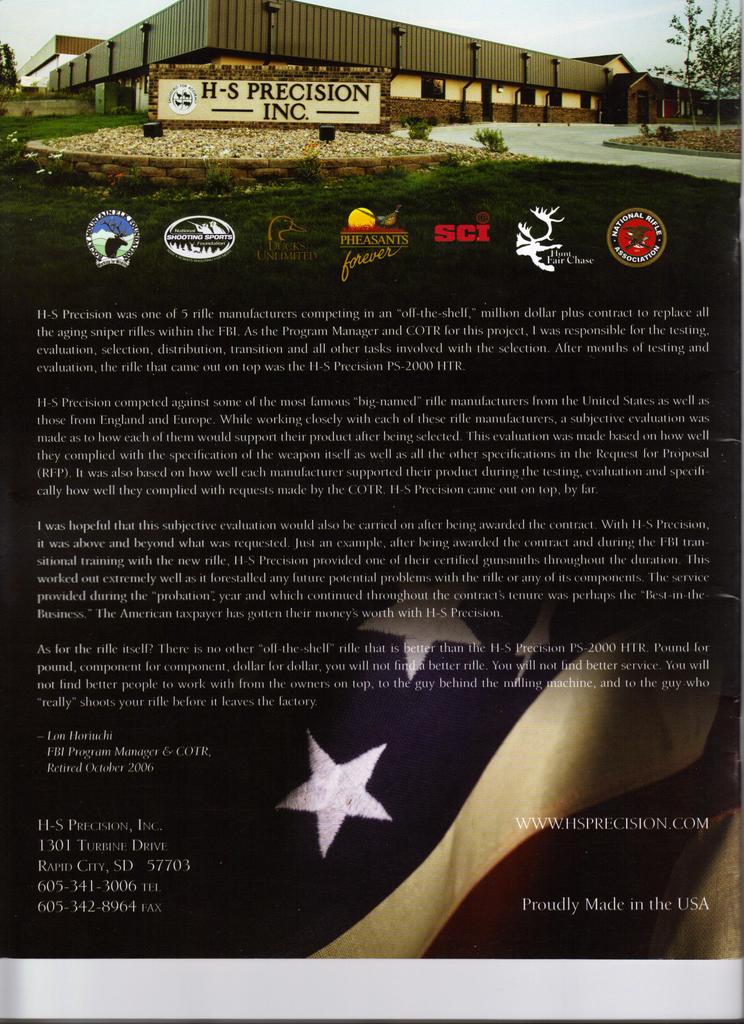H-S Precision Puts Women And Children First
Horiuchi, the man who murdered Randy
Weaver's wife as she stood with her baby in her arms recommends
H-S Precision products, its
rifles. It is rather like
Rudolf Höß, the commandant of
Auschwitz praising
Zyklon B for its effectiveness.


Ruby Ridge ex Wiki
Ruby Ridge was the site of a deadly confrontation and
siege in
northern Idaho in 1992 between
Randy Weaver, his family, his friend Kevin Harris, and agents of the
United States Marshals Service (USMS) and
Federal Bureau of Investigation (FBI). The events resulted in the death
of Weaver's son Sammy, his wife Vicki, and their dog (Striker) as well as
Deputy U.S. Marshal William Francis Degan.
At the subsequent federal criminal trial of Weaver and Harris, Weaver's attorney Gerry Spence made accusations of "criminal wrongdoing" against every agency involved in the incident: the FBI, the USMS, the Bureau of Alcohol, Tobacco, and Firearms (ATF) [ BATF ] aka Jackbooted Government Thugs and the United States Attorney's Office (USAO) for Idaho. At the completion of the trial, the Department of Justice's Office of Professional Responsibility formed a Ruby Ridge Task Force to investigate Spence's charges. The 1994 task force report was released in redacted form by Lexis Counsel Connect, an information service for attorneys. It raised questions about the conduct and policy of all the agencies.
The Ruby Ridge incident and the 1993 Waco siege, involving many of the same agencies and even the same personnel, caused public outcry and fueled the widening of the militia movement. The incident was similar in some ways to the 1985 MOVE conflagration, in which police dropped bombs on a West Philadelphia house. To answer public questions about Ruby Ridge, the Senate Subcommittee on Terrorism, Technology and Government Information held a total of 14 days of hearings between September 6 and October 19, 1995, and subsequently issued a report calling for reforms in federal law enforcement to prevent a repeat of Ruby Ridge and to restore public confidence in federal law enforcement. Likewise, it became a motive, along with the Waco siege, of the Oklahoma City bombing in 1995.
FBI Murderer, Lon Horiuchi Gets A Pass
QUOTE
A week after a sharply divided
federal appeals court ruled that an F.B.I. sharpshooter could stand
trial in a 1992 shooting in Ruby Ridge, Idaho, the county prosecutor
there announced today that he would not proceed with manslaughter
charges against the agent.
''It is unlikely the state will be able to prove beyond a reasonable doubt the criminal act set forth,'' the Boundary County Prosecutor, Brett Benson, said today in a news release issued by his office.
The 11-day siege in August 1992 ended with the deaths of three people: William Degan, a deputy United States marshal; Vicki Weaver, the wife of Randy Weaver, a white supremacist whom federal officials were seeking to arrest on weapons charges; and Samuel Weaver, the couple's 14-year-old son. Along with the Branch Davidian siege [ the Waco Massacre ]a year later, the Ruby Ridge case has been held up by antigovernment groups as an example of the excessive use of force by the federal government.
On June 5, the United States Court of Appeals for the Ninth Circuit ruled, 6 to 5, that the sharpshooter, Lon Horiuchi, could be tried on state manslaughter charges.
That decision was viewed as a major setback for the Federal Bureau of Investigation. Today's announcement by Mr. Benson, while not necessarily quelling the furor over the Ruby Ridge incident, does mean it is unlikely to be revisited in the courtroom soon.
''The Ruby Ridge incident was a tragedy that deeply affected and divided many of the citizens of this county and country,'' Mr. Benson said. ''It is our hope that this decision will begin the healing process that is so long overdue.''
In 1995, the federal government paid Mr. Weaver and his three surviving children $3.1 million in a civil lawsuit stemming from the incident.
Charges of involuntary manslaughter against Mr. Horiuchi had been filed by Mr. Benson's predecessor, Denise Woodbury, but she lost to Mr. Benson in last year's election. Mr. Benson said he would file a motion on Friday to dismiss the case.
Nonetheless, Stephen Yagman, a special prosecutor who had been appointed by Ms. Woodbury to handle the case, said he objected to the decision and hoped that charges might be brought in the future if the county elects yet another prosecutor.
''Were there to be a different prosecutor in Boundary County, the charge, or more severe charges such as second-degree murder, could be refiled,'' Mr. Yagman, who is a lawyer in Los Angeles, told The Associated Press. ''I could not disagree more with this decision than I do.''
Mr. Horiuchi's lawyer, Adam Hoffinger, was out of the country and not available for comment, an aide in his office said this evening. Mr. Weaver, who now lives in Jefferson, Iowa, did not respond to a message left on his answering machine.
Federal courts twice previously
dismissed charges filed against Mr. Horiuchi in the shooting. Last
week's ruling had cleared the way for a state trial to proceed,
although it also would have required a federal judge to find that
there was enough evidence to suggest that Mr. Horiuchi had acted
unlawfully.
UNQUOTE
You might feel that this is blatant
Misconduct In Public Office or Selective
non-Prosecution. Perhaps the right charge would be
Perverting The Course Of Justice.